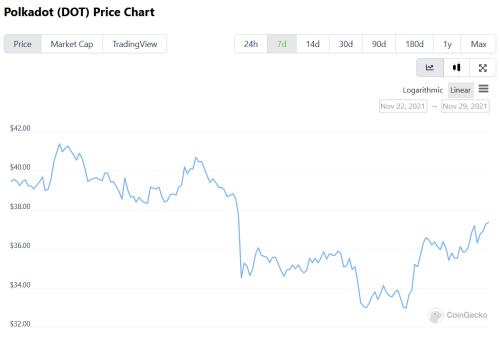Polkadot is a blockchain-based distributed computing platform that lets the blockchains built on top of it, which are called parachains and something we’ll get into indepth in a bit, conduct transactions between themselves. This creates what they call a interconnected internet of blockchains.
It comes with two goals: providing shared security among all of their connected parachains and giving each connected chain the ability to interoperate through cross-consensus communication (XCM).
Polkadot comes with an impressive blockchain pedigree. It’s the flagship product of the Swiss non-profit Web3 Foundation, and founded in 2017 by Robert Habermeier, Peter Czaban annd former Ethereum chief technology officer and co-found Gavin Wood. It was funded by an initial coin offering (ICO) and the blockchain itself went live in 2020.
The idea behind it of course was a series of blockchains that can communicate with each other, but also to allow for forkless upgrades courtesy of its decentralized governance model through on-chain voting using DOT. The governance model also includes certain financial incentives (and disincentives) through their staking and slashing mechanisms, which we’ll get into later.
We have a fair amount to unpack here, so settle in:
What are Parachains?
Parachains are Polkadot’s solution to the interoperability problem within blockchains. Basically, blockchains can’t chat with each other without kind of outside source. Parachains are sub-blockchains built on top of the Polkadot chain that can be used to perform intra-blockchain functions.
They’re custom, project-specific sub-blockchains that feed into the main blockchain, called the Relay Chain, and are considered to be the backbone of the Polkadot network. Parachains share and benefit from the security, scalability, interoperability and governance of Polkadot. DOT’s cross-chain ability allows for any type of data or asset to be sent between parachains, which opens up an entirely new universe of possibilities. Also, parachains can also connect to other networks courtesy of cross-network bridges, making it entirely possible to traffic in other currencies like Bitcoin or Ethereum.
Now you’re asking—but what does it do?
The parachain model was designed with the future of the internet in mind. The idea is that the internet will have multiple different types of blockchains working together. The internet in its present incarnation has many different facets, from streaming services to e-commerce, and in the future blockchains will need to be able to provide a variety of services. One chain could be used for ecommerce, another for gaming, a third for identity management, you get the idea. That’s where the parachains come in. As a product example, imagine the parachain for gaming connects to the relay chain and brings to you the MMORPG you were looking to play. Scalable. Reliable. Fast.
What’s XCM?
XCM doesn’t send messages between systems, instead it’s a format for message transfer performance. It’s a proto-language communication ideas between consensus systems.
It includes the following:
- Generic and extensible for use with fee-free and gas-metered smart contract platforms, community parachains, trusted interactions between system parachains and their relay chain, and more.
- Interacting with a system whose transaction format is unknown.
- XCM is well-versioned, abstract and general and can be used as a means of providing a long-lasting transaction format for wallets to use to create many common transactions. It is extensible, and, in turn, future-proof and forwards-compatible.
- Highly efficient to operate in a tightly constrained and metered environment, as is the case with many chains.
How does this relate to Web 3.0?
We should likely define adequately the difference between Web 1.0, 2.0 and now 3.0.
Web 1.0
In the beginning there was web 1.0. Few content creators and many consumers. Personal web pages are common and consist of static pages hosted on ISP-run web servers, or on free web hosting services. Anyone remember Geocities? Yeah. Web 1.0.
Advertising on websites while surfing the net is banned. We start seeing the rise of digital photography sites where you can store your avatars and roleplaying character visuals. There are BBSs and MUDDS, and you get the idea.
Web 2.0
When folks talk about web 2.0 they’re talking about worldwide websites, user-generated content, usability and interoperability for end users. It includes a rise in a participatory angle, and not necessarily any kind of technically specific modification, but the way we as users interact with the web. Here we see the rise of interaction and collaboration in a social media dialogue, as creators of user generated content in a virtual community. We still have all the baseline functionality of web 1.0, but we can now functionally include user generated communities like YouTube, Facebook.
In terms of commerce, advertising is no longer verboten and is considered the standard. Now in addition to Facebook and YouTube and the like we have the addition of communities and social entities like Amazon, Linkedin, Airbnb (and the entire gig economy, which is a byproduct of web 2.0) Alibaba and Twitter, which offer multifunctional experience across any and all devices. The principle problem, of course, with Web 2.0 is that this interconnectivity comes with a number of different issues. First, it’s overly centralized, which can lead to excess profit focus, unreasonable advertising types, mass surveillance, increased security risk, the death of privacy and the overwhelming issue of data theft.
Web 3.0
The series of initiatives that correspond to web 3.00 are a reaction to the issues raised by web 2.0. The idea is that the technology we’ve grown to rely upon in our daily lives has fallen short of ethical and moral standards required for human interests, human rights and well-being. The response includes a significant call to action from the globally recognized urgent need to create and use technologies that are more human centred rather than an explicit focus on the profit motive, or in the service of power. That’s where polkadot’s next-gen blockchain protocol comes in.
Also, there’s a lot more to this coin and the foundation behind it, and this information should really just be considered a primer. As always, do your own due diligence before getting into this or any other investment.
What does this have to do with you?

Right now Polkadot is the eighth largest coin by market cap at $39,725,690,459. Unfortunately, it is correlated with Bitcoin, meaning when BTC takes a dive, so does DOT. But whereas cryptocurrency generally doesn’t have fundamentals like a PE Ratio or revenue to base an executive decision off of, DOT at least has functionality and promise. The idea of a decentralized internet-of-internets is a curious one with widespread options for appeal and development. Even if you’re interested in speculation—DOT’s reasonably cheap and shows vast upside, having grown 664% in the past year—and as Web 3.0 takes off, who knows where this might lead?
—Joseph Morton


Leave a Reply